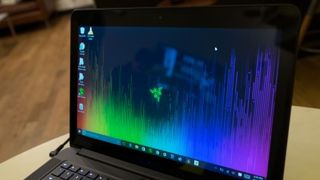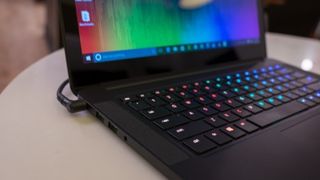Why you can trust TechRadar
Likely responding to desire for more choice, Razer has widened its options a bit for Blade purchasers. When buying a Blade, you have three choices per screen option now: 256GB, 512GB or 1TB of SSD storage?
This being a gaming laptop, surely you know that this question has at least one wrong answer.

You’re going to want 512GB of storage at minimum, with the average PC game eating up 10 or more gigabytes on a hard drive these days. For that, you’re paying at least $1,999 or £1,949/AU$2,999. If it doesn’t look like much has changed since last year, that’s because it really hasn’t. The processor is still a 6th generation Intel Skylake part and the Thunderbolt USB-C port remains – and now the Nvidia GTX 1060 is featured throughout all models.
You’re going to want that 512GB sooner or later and, especially if you’re not willing to void any warranties by installing a larger SSD on your own, you won’t have many options.
That the Alienware 15 offers a 128GB SSD-plus-1TB hard drive bundle (with largely the same components otherwise) for $300 less, as of December 2016, should put the Blade’s modus operandi into context.
Meanwhile the 15-inch MacBook Pro for late 2016 offers just 256GB of storage and the same amount of RAM with AMD’s Radeon Pro with 2GB of video memory starting at a whopping $2,399 or £2,349/AU$3,599.

So, the Blade’s value is easily bested by competing Windows laptop makers, whereas Apple can’t come close. Razer has made great lengths to make the Blade more affordable, but apparently so did everyone else but Apple.
The result is a gorgeous laptop that might be an even stronger video editing and gaming machine than Apple’s for hundreds less. And, if portability and style aren’t your chief concerns for a productivity-and-play machine, you can easily get more power and space for less.
At any rate, how does the new Razer Blade perform with its new graphics chip?

Performance
The Razer Blade is, unsurprisingly, among the strongest-performing gaming laptops you can buy today. The upgrade to the laptop’s graphics this time around is much more pronounced than a mere video RAM bump. The generational leap from 900 to 1000 series GPUs is apparent in the Blade’s latest benchmark scores.
Here's how the Razer Blade held up under the scrutiny of our benchmark tests:
3DMark Cloud Gate: 18,301; Sky Diver: 20,468; Time Spy: 3,502; Fire Strike: 8,540
Cinebench CPU: 674 points; Graphics: 97 fps
GeekBench 3: 3,500 (single-core); 13,184 (multi-core)
PCMark 8 (Home Test): 3,358 points
PCMark 8 Battery Life: 3 hours and 32 minutes
Battery Life (TechRadar movie test): 5 hours and 21 minutes
The Division (1080p, Ultra): 46 fps; (1080p, Low): 76 fps
GTA V (1080p, Ultra): 34 fps; (1080p, Low): 113 fps
A number more than 2,000 points higher than the previous model in Fire Strike all but guarantees reliable frame rates in most games at 1080p resolution with the settings tweaked to your preference. However, not even the latest graphics chip can handle every game at the highest possible settings in that resolution, clearly.
Each in-game benchmark sees increases by more than 10 frames per second, yet are still well below 60 fps at Ultra settings. With that in mind, consider what the 3,200 x 1,800 IGZO screen is getting you, as gorgeous as it is.
Of course, many of you are likely saying to yourselves (again) that the same performance in laptops can be found for way less. Trust us, we know. But (again), remember that few, if any, of those options are built anything like the Blade.
Gaming aside, the new Blade will be able to handle pretty much every task that the average user would think to throw at it with aplomb. With Thunderbolt 3 and a GPU with triple the video RAM, creative professionals might find this laptop to be an even better proposition than the latest MacBook Pro. However, there’s one area in which the MacBook Pro will win every time against the Blade.
Battery life
For an Ultrabook with a higher-than-HD resolution and dedicated graphics, the Blade actually offers decent longevity. A shocker, we know, though it’s testament to Intel and Nvidia’s hard work on the power management front and in part to Razer’s refined design in terms of thermals and space.
With this revision, battery life remains largely unchanged, but pales in comparison to the 15-inch MacBook Pro’s 7 hours and 45 minutes of juice that we tested. (Especially considering our test unit sports a 1080p screen.)
While its PCMark 8 Battery Life score remains more than 3 and a half hours, the machine lasted for 5 hours and 21 minutes in our local video loop test at 50% brightness. That’s a mighty long time for something with all the parts to qualify as a “gaming laptop,” but a bit below the score we recorded in August 2016.
[Editor's Note: We suspect that our PCMark 8 result differs from Razer's promise of 5 hours because our testing parameters differ slightly, as noted via our link above the Benchmarks sidebar.]

Razer pegs the Blade at 5 hours based on its own runs of the PCMark 8 Battery Test, so our benchmarks aren’t far off.
Granted, you won’t get these numbers while playing games or editing several streams of HD video. Regardless, the Blade looks like a slick companion for getting some work or play in with on those nationwide flights.
While still out of reach from many, Razer’s vision for its leading laptop is all but refined. This year’s last edition is a revision on the existing design, but the brand new graphics could help Razer achieve status in a wider subgroup of the well-to-do: creative professionals – especially now that, in some areas, the Blade is a better deal on paper than Apple’s latest MacBook Pro.
The video editor that just so happens to be a PC gamer, it looks like Razer’s after you with this green machine. And, with stronger graphics than ever, it’s definitely worth your consideration.

We liked
Razer has crammed more into its Blade laptop than ever while somehow making it the lightest it has ever been all over again. More (and better) ports and stronger graphics with the same battery life – yet, there’s a (albeit barely) smaller device containing it all.
The updated and improved Chroma keyboard lighting brings fun and personalization to the experience of using a Blade, but also tactical advantage and an overall more premium look and feel. Who knew that the arms race between Alienware and Razer would really be about keyboard lights?
We disliked
While Razer has widened the available options when purchasing a Blade in bringing back the Full HD screen option and three storage options, it would be nice to tweak other parts of the system before checkout, like RAM and even the GPU. Understandably, that would require more engineering work on Razer’s part to ensure more parts work with its chassis designs.
And, new graphics are always a welcome addition, but this time around they’ve made the Blade a bit louder than we’d like. While headphones might save your ears from competing over the fans to get that cutscene dialog, those around you will undoubtedly hear the turbines.
Final verdict
We’ve always appreciated Razer’s Blade gaming laptops for their attention to build quality and design. It’s something that, at the time of their debut, was a bit lacking in the world of Windows notebooks. From the start, Razer has always been after a very specific type of gamer.
And, it’s with this latest revision that we finally see who that is. With the addition of Thunderbolt 3 and now the latest graphics tech: Razer has made its Blade a rather appealing option to people that both work (or study) in visual fields and happen to be PC gamers.
It’s a broadened niche nevertheless, but at least this one is easier to understand (or let pass without silent judgment from the DIY diehards) than simply “PC gamers.”

Being focused on value at TechRadar, Razer’s laptops have always been difficult to sum up. There’s no doubt about the Blade’s build quality and attention to detail, not to mention its graphical capabilities.
It will always be true that the same level of performance can be found within laptops that are generally bulkier and uglier (albeit lacking in modern features by comparison) for hundreds less. But now, with an even further reduced price when stacked up to the leader in laptops for creative types, Razer’s proposition puts the question of “what’s valuable to you?” front and center.
With stronger graphics than ever, the new Razer Blade is the veritable MacBook Pro of the PC scene, with all of the well-earned, esteemed accolades (and small derisions) that implies.
Joe Osborne is the Senior Technology Editor at Insider Inc. His role is to leads the technology coverage team for the Business Insider Shopping team, facilitating expert reviews, comprehensive buying guides, snap deals news and more. Previously, Joe was TechRadar's US computing editor, leading reviews of everything from gaming PCs to internal components and accessories. In his spare time, Joe is a renowned Dungeons and Dragons dungeon master – and arguably the nicest man in tech.

Scientists inch closer to holy grail of memory breakthrough — producing tech that combines NAND and RAM features could be much cheaper to produce and consume far less power

Google adds biometric verification to Play Store to keep your in-store wallet safe

Quordle today – hints and answers for Wednesday, April 17 (game #814)

